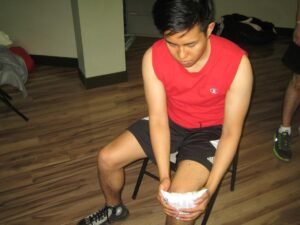ACL injury typically involves the tearing of the ACL (anterior cruciate ligament) that is located within the knee joint. This injury is common during sports such as soccer, basketball, volleyball and tennis. Take note that these sports usually involve abrupt stops as well as changes in the direction.
Right after this injury is sustained; the knee will swell, become unstable and pain manifests especially if bearing weight. In most cases, one will feel or hear a popping sound in the knee if the ACL is injured. Depending on how severe the injury is, the treatment can include surgical intervention in order to replace the damaged ligament and followed by rehabilitation exercises to restore stability and strength.
Symptoms of an ACL injury
- Popping sound on the affected knee
- Pain and difficulty in performing activities
- Swelling of the knee that tends to worsen after the injury was sustained
- Instability if bearing weight
Always bear in mind that it is important to seek medical care right after an ACL injury.
Causes of ACL injury
The anterior cruciate ligament is one of the two ligaments that cross in the middle of the knee and responsible for connecting the femur to the tibia. Additionally, it also helps in stabilizing the joint in the knee.
If an individual is engaged in sports and fitness activities, there is a tendency for the ligament to tear when changing direction abruptly or when pivoting with the foot planted firmly on the ground as well as hyperextending the knee. Even landing from a jump can injure the ACL and falls when engaged in downhill skiing.
Vehicular accidents and contact sports can also cause the injury but majority of ACL injuries can occur without any contact.
How an ACL injury is treated

The aim of the primary treatment for an ACL injury is to minimize the pain and swelling in the affected knee, restore normal joint functioning and to strengthen the muscles surrounding the knee.
Your doctor will also decide if surgery followed by rehabilitation is needed or simply rehabilitation alone. The choice usually depends on certain factors which also include the severity of the damage to the knee and your willingness to adjust your activities.
As for the athletes who want to continue with sports that involve jumping, cutting or pivoting, they can opt for surgical reconstruction in order to prevent instability in the future. For sedentary individuals without significant damage to the ligaments and cartilage, they can maintain knee stability with the help of rehabilitation.
Preventing ACL injuries
There are various ways to minimize your risk for an ACL injury.
- Improvement of your conditioning exercises – an effective routine usually involves stability and strengthening exercises, aerobic conditioning, jump training, plyometric exercises and risk-awareness training.
- Hamstring strengthening
- Utilizing proper techniques in any sports activity. With technique training, it should be accompanied with strengthening to lower down the risk for injuries.
